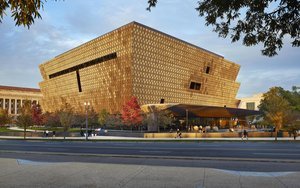By Carver student Rodelin Constant
Now that the business portion of our trip has ended, we embarked on our planned visit to the National Museum of African American History & Culture in Washington, D.C.
The museum nicknamed the "Blacksonian," opened in 2016 as the 19th and newest museum of the Smithsonian Institution. We were immersed in over 400 years of African American history and culture when we stepped inside the stunning bronze-colored building.
This visit was a gift after touring 10 Universities. Before even entering, the intricate design of the exterior caught my eye. As we walked in, we were greeted by armed security, which ensured the safety of the guests.
Our first stop was at The Sweet Home Café, located at the lower level, where we savored the tasty homemade soul food dishes like fried chicken, fried whiting, pulled pork, Mac and Cheese, sweet potato, potato salad, and many desserts.
After finishing our delicious meal, we started the tour at the European Slave Trade Exhibition. I never realized how far back slavery dates; I was reading memoirs and passages that dated back to the 1500s. The beauty of the museum was how they showed both sides of the coin. Africa was a country far more advanced and developed than European history shows. Civilizations, resources, kingdoms, and the continent were plentiful. That’s the reason why the Europeans were over there. Back then, all countries modeled themselves after Africa. The Europeans learned war strategies, mathematical equations, and astrology from the Africans. That’s to name a few.
I also learned how slavery, or indentured servants as they were called, wasn’t as uncommon. It was as common as trading gold or spices. Somewhere along the way, though, Europe, South America, and North America targeted Western Africa as a prime location for slave cargo. Throughout the exhibit, I learned about the brutalities and inhumane treatment that slaves went through.
The voyage alone had its exhibit. For Europeans to get Africans from Western Africa, they went in forcefully. Rifles, swords, chains, and whips. Invading homes, tribes, and civilizations. Men, women, and children were caught, bound, and chained together on a boat. Ones who refused or rebelled were murdered, women were raped, children separated from their parents, and men emasculated.
I learned how the Europeans didn’t care about anything but their “cargo,” Africans from all tribes and nations packed and chained together like sardines. Men were chained by their ankles and wrists and were surveilled by a guard with a whip to keep them in line. Women were only chained by the wrist, and separated from the men, only to be raped and brutalized. Thousands died at the hands of their captors, to disease, or even by choice. Believing that death would bring them back to their homeland.
What fascinated me the most about the entire experience was how much Black culture is American culture. How much pain we’ve turned into passion. When we were all on one accord, we impacted art, fashion, music, entertainment, politics, and inventions throughout the country.
In one way or another, African/ Black culture has influenced our way of life. I bet you know someone who isn’t black and loves Air Jordans. Have you ever considered how unsafe driving would be without stoplights? What about a nice bag of potato chips to enjoy a sandwich? The museum celebrates Black excellence and achievements, from The Carver’s namesake, George Washington Carver, 's agricultural inventions to Chuck Berry's rock' roll guitars.
I believe every young black student should tour the NMAAHC because of the sense of pride you feel leaving. The balance in depicting our history is the pain of our people, our resilience, the joy of our accomplishments, and the pride of our contributions to American culture.
I am filled with pride and understanding that we come from a long line of powerful, creative, and innovative people. There’s nothing impossible because when the odds were all stacked against my people, they prevailed. I left the museum feeling something indescribable.
Thank you, Carver!



